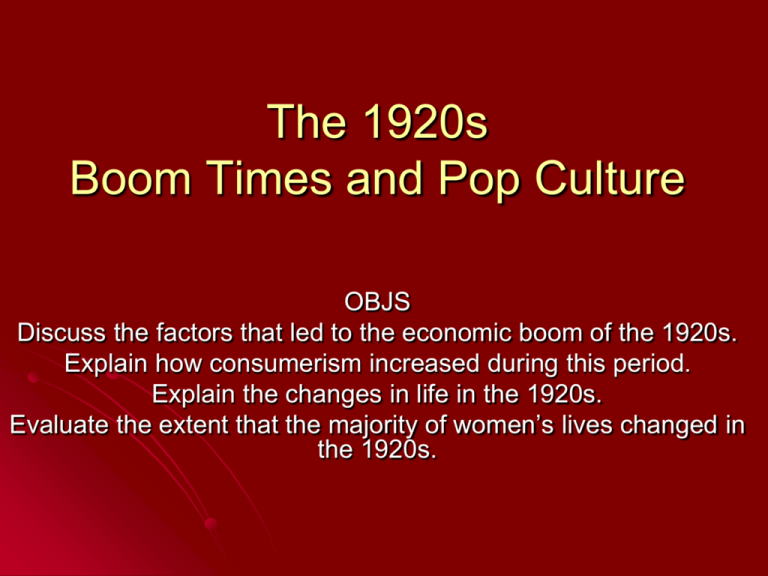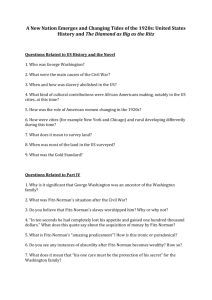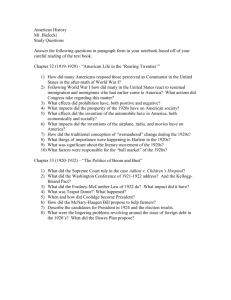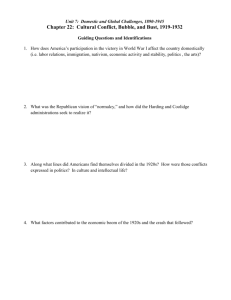The 1920s Boom Times and Pop Culture
advertisement

The 1920s Boom Times and Pop Culture OBJS Discuss the factors that led to the economic boom of the 1920s. Explain how consumerism increased during this period. Explain the changes in life in the 1920s. Evaluate the extent that the majority of women’s lives changed in the 1920s. Bellringer Compare the ads from the next slide – 1920s emerging consumerism 2008 ad Consumerism Intro The war is over –what will the factories produce? 1. And 2. -Characteristics of the Economy and Boom Times Prosperity and Productivity Factors Republican Pro-business stance Abundant supplies of energy Wealth concentrated in a few Demand for new electrical appliances New “wonder” materials – plastic, rayon, acetate, etc… Factors con’t The Assembly Line Ex: Henry Ford and the Model T – production costs decreased/supply increased Impact of the assembly line on the Auto industry Large Corporations formed Small Corporations went out of business The Big Three remained –Ford, General Motors and Chrysler Auto Co’s in 1920s = America’s largest business What role did the Republicans play in this? Changes in Work Assembly line decreased skilled labor jobs Shorter workdays/Higher wages Frederick W. Taylor and scientific management –created “white collar” management jobs Power of Labor Unions decreased Domestic change Housewives – reduced # of housekeepers and delivery people – took over the jobs with electrical appliances and autos What changes occurred in America due to the increased # of Autos? 400 K miles of highways built Public Transportation Decreased Decreased population of inner cities/Growth of the “suburbs” More contact between the rural and urban Americans Camping trips Decreased Sense of “Neighborliness” Teenagers – more freedom Pollution/Traffic Jams/ Parking Problems Increased Accident Rate Creating Consumers “To keep America growing we must keep America working, and to keep America working we must keep them wanting; wanting more than the bare necessities; wanting the luxury and frills that make life so much more worthwhile, and installment selling makes it easier to keep Americans wanting.” (p. 651) Advertising Played on peoples’ hopes and fears Celebrity pitches Jingles and slogans Chain Stores (A & P) Merchandising Easy credit/installment plan Life in the 1920s Popular Entertainment Radio Programs Music Advertisements 3. Intolerance Sacco and Vanzetti Trial Resurgence of the KKK Immigration Acts of 1921 and 1924 4. Moral Issues of the Time The New Woman Fundamentalism Prohibition Moral Issues/The New Woman Flappers = no corsets, shorter skirts and hair (bobs), transparent hose, wore make up, drove cars and many smoked Minority and NOT the IDEAL! Had social and economic freedoms Movies Lavish theaters Silent Movies (Valentino, Chaplin, and Garbo) 1927 –”Talkies” begin Celebrities and Heroes Rudolph Valentino Babe Ruth Helen Wills Gertrude Ederle Jim Thorpe Closure Read and discuss p. 657







